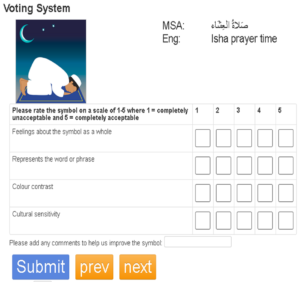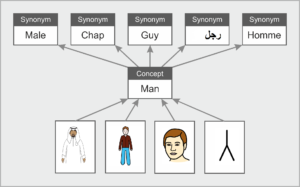Today we are pleased to share a guest post by EA Draffan and David Banes on their work in the area of developing culturally appropriate symbols. If you enjoy this post, the authors are also presenting a USSAAC-sponsored webinar on June 4th entitled Global Systems: Design and Use of Symbols that Reflect Local Language and Culture.
Introduction to Symbols
There is a history of complexities that surround the design, development, and use of symbols to support augmentative and alternative forms of communication (AAC). Therapists often used cut out magazine images, pictures from children’s books, photographs and hand drawn outlines. Pictographic symbols were then developed for use alongside gestures and later, pictorial symbols in colour for computer-based systems.
As software and symbol systems multiplied and more people were working in an international field, questions arose not only about the complexities of programming AAC speech generating devices, but also the suitability of some representations of linguistic concepts that did not fit in a multicultural society. In other words, the iconicity of a symbol could confuse and even be distracting to the user because it either lacked meaning or made the user feel alienated.
The Arabic Symbol Dictionary Project
In 2014, research had already shown the importance of the linguistic, cultural, and social relevance of symbols to AAC users[i] when we embarked on an Arabic symbol dictionary project in Qatar. The local team did not want to make a new symbol set, as well-known symbols were already in use in some schools and clinics. However, we were aware that these were not available to all families and when meeting potential participants in the project, it became clear that not all the symbols were suitable. Crucially, early meetings with AAC users and those supporting them gave the team a chance to think about democratizing symbol choices.
Initially, a voting system was devised to choose a suitable free symbol set, which had a creative commons license. The voting was held online and face-to-face with a choice of three free sets of symbols. As most of the AAC users were children, the selection of the Aragonese Portal of Augmentative and Alternative Communication (ARASAAC) symbol set from Spain appeared to be the most popular alongside those symbols already in use. The initial voting system required a considerable amount of explanation by team members, so this proved to be a useful pilot for the voting system developed for making individual symbol choices. The participants not only chose the initial design style of the symbol set by choosing ARASAAC, but also had choices of the development of the voting system.

Symbol Voting Scale
While a local graphic designer began the process of drawing the first batch of symbols representing some Arabic core linguistic concepts provided by local teachers, specialists, families, carers and AAC users, the project team developed the chosen flash card voting system. This consisted of a 1 to 5 scale where 1 was not acceptable, and 5 was completely acceptable based upon four criteria (See Figure 1) namely:
- Feelings about the symbol as a whole
- Represents the word or phrase
- Colour contrast
- Cultural sensitivity.
The participants in the voting procedure could add comments and the system was adapted to support the device and skills of a participant who was an AAC user. Therefore, it was possible to use ‘yes’ or ‘no’ as the symbols appeared on the screen.
Participants could vote on a batch of 60 symbols in a morning using a face-to-face paper-based system or vote directly online. The face-to-face meetings over coffee or lunch produced some of the best results as people were far more willing to discuss the issues that arose compared to when working alone online. The AAC users often indicated the strongest preferences for certain symbols against others that they felt completely misrepresented what they wanted to say.
When symbols failed to reach 3.5 on the scale, they were sent back to the graphic designer and the team would often debate individual symbol issues using a social media image service. The results were collated and presented to the participants in graphs to illustrate how their work impacted the outcomes. The next batch would include the amended symbols along with any new requests. After a year of symbol requests, the team found that cultural differences were the least of their worries, as teachers began to include more abstract linguistic concepts. Scores for cultural acceptance rose and scores for the correct representation of a word reduced! Try drawing a symbol for monotheism!
The final 700 symbols produced were made available for free, using a wide-ranging creative commons license and included black and white copies of the images for those with visual impairments. The symbols that tended to require the most frequent changes were those related to religion and dress. The criteria also demonstrated the importance of the local environment, social settings, and family and friendship dynamics. Interesting issues were presented such as working from right to left in Arabic and supporting larger fonts on speech generating devices because Arabic script requires all its diacritics to be in place for good text and speech pronunciation.

“I want to see family and friends” symbol in Arabic.
Thoughts for the future

Very basic symbol linking to concepts.
Setting up the Global Symbols repository of freely available pictographic symbols has allowed us to explore the linking of symbols to linguistic concepts using ConceptNet. While this is still a work in progress with the support of UNICEF, we have furthered the process of harmonizing symbol sets started by Mats Lundälv and Sandra Derbring[i]. When symbol sets are uploaded there is a plan to automatically link them to parts of speech, synonyms, descriptions, and topic categorizations. Using machine learning and natural language processing it is hoped that we will be able to improve the accuracy of these classifications. This in turn will enhance the search and filtering of symbols to speed up just-in-time programming [ii] for the development of communication charts and visual scene displays with easier use of open multilingual international symbol sets. Artificial intelligence or augmented and assistive intelligence has already become a tool to support AAC with the use of prediction and learning analytics in apps for Android and iPad tablets and we would like to build on these successes.
Looking to the future, hopefully, with user participation and symbol set harmonization across languages and cultures, we can increase the range of symbol access for everyone. Then perhaps we can also dream of solving the difficult problems that remain when trying to generate multilingual understandable grammatically correct sentences from a series of symbols. The text to speech output still depends on accurate text, but maybe having larger data sets and improved algorithms to support machine learning better predictions or different ways of developing AAC will evolve.
References
[i] Huer, M. B. (2000). Examining perceptions of graphic symbols across cultures: Preliminary study of the impact of culture/ethnicity. Augmentative and Alternative Communication, 16: 180-185.
[ii] Lundälv, M. and Derbring, S., 2012, July. AAC Vocabulary Standardisation and Harmonisation. In International Conference on Computers for Handicapped Persons (pp. 303-310). Springer, Berlin, Heidelberg.
[iii] Caron, J., Light, J. and Drager, K., 2016. Operational demands of AAC mobile technology applications on programming vocabulary and engagement during professional and child interactions. Augmentative and Alternative Communication, 32(1), pp.12-24. https://doi.org/10.3109/07434618.2015.1126636
—-
E.A. Draffan trained as a Speech and Language Therapist initially working in clinics and a large general hospital and began specialising in assistive technology across all disabilities. She moved into education, but her interests remain focussed on the successful use of assistive technology strategies for those with communication and literacy difficulties with work involving the use of apps, e-books, speech generating devices, text to speech and AAC symbol support.
David Banes is Director of his company David Banes Access and Inclusion Services, with an interest in how technology supports persons with learning disabilities, both children and adults and including autism, dyslexia and profound and complex needs. Recent projects include research into the impact of disruptive innovation upon accessibility, a business case for investment in assistive technology, and supporting entrepreneurs to bring products and services to market. He has a special interest in the use of technology to support those with disabilities in low and medium countries and refugees.
The authors have no financial or nonfinancial relationships to disclose.
—-
Jill E Senner, PhD, CCC-SLP
Editor-in-Chief
SpeakUP
